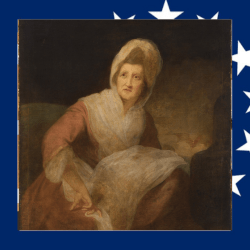
Unfortunately, reflection on famous female artists pre-1960 yields quite limited results. For many centuries, art was considered to be a “man’s profession,” and while there were women who engaged in the creation of it, their work was often not displayed publicly or given the recognition that they deserved.
However, the first American-born recognized sculptor broke many of these stereotypes and became a prominent figure in American art history. Patience Wright, born in 1725 in Oyster Bay, New York proudly created wax-figure sculptures that displayed that women could possess the same degree of extraordinary talent that a man may have. She even went on to monetize her profession, ensuring that the public witnessed that it was possible to be appreciative of a female artist’s work.
A Quaker, Patience was a vegetarian—another uncommon choice for people during the time of the American Revolution! She married a man named John Wright at the age of 16, moving to Philadelphia to be with her new husband. The city life contrasted with her somewhat rural upbringing, and her class was reflective of John’s occupation as a barrel maker. Up until 1796, when her husband suddenly passed away, she lived life as a homemaker and mother, taking up sculpting only as an occasional pass time.
Once widowed and lacking the income of her husband she was forced to find an inventive solution to keep her from destitution. Patience and her sister worked together to turn their hobby of wax sculpting into a business! She traveled abroad to London, attempting to mingle with upper-class society, only to find herself and her sculpting style to be criticized for lack of refinement. Wealthier individuals preferred to sculpt out of metal or stone, and using “lowly” materials such as wax was looked down upon by the richer classes.
Though discouraging, this did not stop Patience from making a brand for herself and selling her works. At the time of the American Revolution, Patience was living in England but still showed her support from afar through letters and fundraising campaigns to support American activists. She even gathered information from British prisoners of war and sent it across the sea for Revolutionaries to learn from.
Having successfully declared independence, she hoped to return to America to witness all that her home country had become. Ready to leave England, her uniquely American manners which were once criticized and scorned, evolved into her signature trait and assisted Patience in gaining popularity amongst Londoners. She planned to return to the States more well-off than she had left them, but unfortunately, tragedy interrupted those plans.
About to embark on a boat trip across the Atlantic Ocean, Patience suffered a grave fall and passed away on March 23, 1786. While her exact injury is unknown, one can theorize the absolute shock it sent through her family. Her sister appealed to the Continental Congress to have Patience’s funeral costs covered on grounds of her providing invaluable information to the American cause, but they refused. The newly formed American government did not want to recognize Patience and the necessary contributions she made in the battle for independence.
Today, only one of her sculptures remains. While there are many unanswered questions surrounding her life and death, including the location of her grave, Patience represents one of the many American women who refused idleness in the face of the Revolution and used their own unique skills to help the fight for American liberty in whatever way possible.
